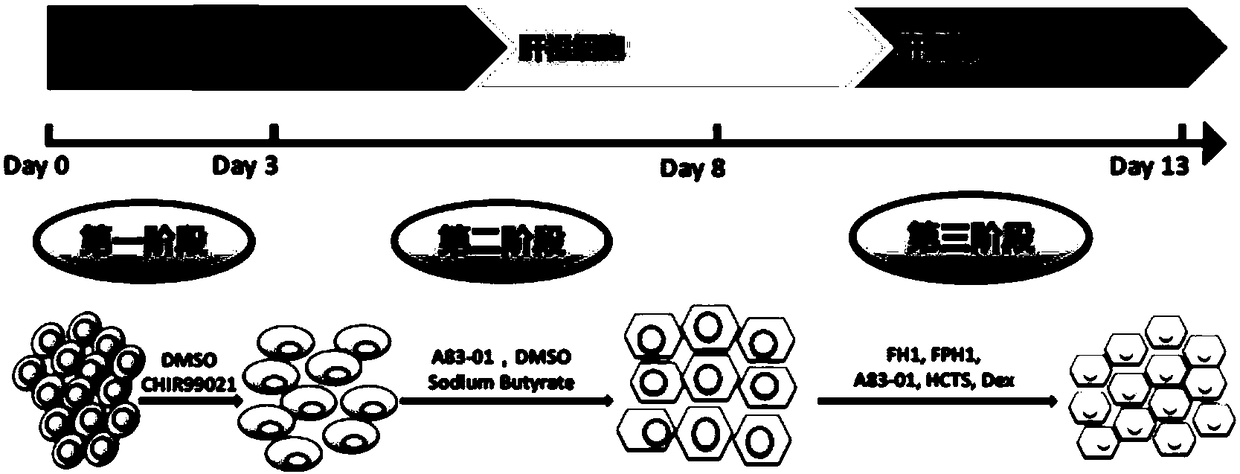Method used for inducing differentiation of human pluripotent stem cells into hepatocytes using small molecular compound
A technology of human pluripotent stem cells and small molecule compounds, applied in the field of stem cell biology and regenerative medicine, can solve the problems of poor reproducibility, difficult induction, and unstable experimental system.
- Summary
- Abstract
- Description
- Claims
- Application Information
AI Technical Summary
Problems solved by technology
Method used
Image
Examples
Embodiment 1
[0152] Example 1 Inducing Human Pluripotent Stem Cells to Differentiate into Hepatocytes
[0153] A method for inducing human pluripotent stem cells to differentiate into hepatocytes (the flowchart of the differentiation process is shown in figure 1 ), divided into the following three steps:
[0154] S1. Inducing Human Pluripotent Stem Cells to Differentiate into Definitive Endoderm
[0155] Method: (0.5% DMSO+human embryonic stem cell medium mTeSR) was pre-cultured for 24 hours, then cultured with (RPMI1640+insulin-free B-27 cell culture supplement+CHIR99021 (3μM)) for 24 hours, and then replaced with insulin-free B-27 RPMI1640 medium with 27 cell culture supplements, continued to culture for 24 hours, after a total of 72 hours of culture.
[0156] The specific plan is:
[0157] (1) Preparation for induction of differentiation 24 hours in advance: Coat a six-well plate with Matrigel and put it in a 37-degree incubator; the confluence of human pluripotent stem cells is 70-9...
Embodiment 2
[0169] (3) Continue culturing for 5 days, and replace fresh medium every day to promote the differentiation of hepatic progenitor cells into hepatocytes. Example 2 Optimization of Conditions for Inducing Human Pluripotent Stem Cells to Differentiate into Definitive Endoderm
[0170] 1. Effects of different basal media on stem cell pluripotency and endoderm differentiation
[0171] Comparison of the effects of two media on stem cell pluripotency and endoderm differentiation
[0172] Medium 1: Essential 8 TM Medium
[0173] Medium 2: 1640B27 medium, RPMI1640 medium containing insulin-free B-27 cell culture supplement, wherein the volume ratio of RPMI1640 medium to insulin-free B-27 cell culture supplement is 49:1.
[0174] 1. Operation method
[0175] (1) Embryonic stem cells H1 were inoculated in a 6-well plate 24 hours in advance, so that the cell fusion degree before induction reached 30-50%;
[0176] (2) When inducing differentiation, add 3 μM CHIR99021 to Essential8 an...
Embodiment 3
[0204] Example 3 Condition optimization for inducing the differentiation of defined endoderm into hepatic progenitor cells
[0205] In order to determine the effect of (A83-01+NaB+DMSO) in inducing the formation of hepatic progenitor cells, a traditional cytokine group (BMP4+FGF4) was designed as a comparison.
[0206] 1. Operation method
[0207] After the embryonic stem cells H1 were induced into defined endoderm according to the optimal scheme above, the medium was replaced with the hepatic cell induction medium: GlutaMAX, non-essential amino acids (NEAA), B-27 cell culture supplement, Fatty acid complex (Chemically Defined Lipid Concentrate) and serum replacement (Knockout TM Serum Replacement) with a volume of 95:1:1:1:1:1. Among them, the traditional cytokine group was supplemented with 10ng / ML of BMP4 and 10ng / ML of FGF4; the small molecule compound induction group was supplemented with 0.5μM A83-01, 200nM NaB and 0.5% DMSO. The induction time was 5 days, and fresh i...
PUM
 Login to View More
Login to View More Abstract
Description
Claims
Application Information
 Login to View More
Login to View More - R&D
- Intellectual Property
- Life Sciences
- Materials
- Tech Scout
- Unparalleled Data Quality
- Higher Quality Content
- 60% Fewer Hallucinations
Browse by: Latest US Patents, China's latest patents, Technical Efficacy Thesaurus, Application Domain, Technology Topic, Popular Technical Reports.
© 2025 PatSnap. All rights reserved.Legal|Privacy policy|Modern Slavery Act Transparency Statement|Sitemap|About US| Contact US: help@patsnap.com



